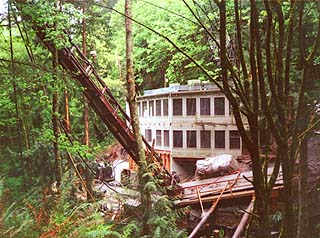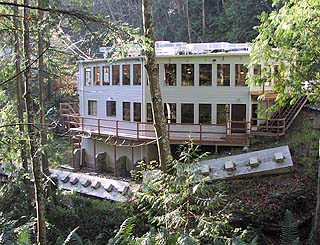
Surveys
DJC.COM
July 25, 2002
A pearl of a project on Oyster Creek
Shannon & Wilson

Walter |
Located on Chuckanut Drive southwest of Bellingham, the inn is perched on a 45-degree bank above Oyster Creek. The environmentally-sensitive creek supports salmon and other critical habitat, and discharges into commercial oyster beds less than one mile away.
The inn was built on steep, unengineered roadfill over weak serpentinite bedrock. Slow, deep-seated landslide movement and settlement of the fill had affected the structure over the years. The unreinforced concrete masonry (URM) foundation walls and concrete footings had settled and moved laterally, causing large cracks in the URM walls and a noticeable outward tilt. Water had ponded in the parking lot because of the landslide-induced settlement, which further reduced stability by promoting surface water infiltration.
The structure was generally seismically deficient. The owner had closed the restaurant until landslide repairs and seismic structural upgrades could be designed and constructed.

Photos courtesy of Shannon & Wilson Temporary timber rakers supported the concrete anchor during installation of tieback anchors without disturbing the creek banks.
|
Rebuilding was out of the question, since ecologically significant locations like these rarely receive permits anymore. Repairs using traditional soldier or cylinder pile walls had been proposed previously. However, these types of repairs would have been expensive and impractical to construct due to the site’s constraints. The staging area along twisting, narrow Chuckanut Drive was minimal, and the steep slope between the inn and Oyster Creek limited.
Shannon & Wilson, geotechnical and environmental consultant for the project, designed an innovative and cost-effective system to improve both slope stability and the building’s foundation.
The solution featured permanent prestressed tiebacks that restrain a continuous concrete ground anchor beam to improve slope stability. Micropile underpinning was installed to support building footings undermined by erosion and slope movement.
All of the repairs were designed so they could be constructed using lightweight construction equipment that could be lifted into the limited space between the inn and Oyster Creek. The result was a project that won two prestigious awards.
Resolving risks
The design team decided to stabilize the downhill perimeter footings, which were undermined, before beginning the landslide repairs. Footings were first underpinned with micropiles, then tied into a rebuilt foundation system consisting of existing footings plus new grade concrete beams and foundation walls.
Next, temporary timber rakers were put in to support the anchor beam during concrete placement and installation of tieback anchors. The rakers extended to a firm bearing in talus on the opposite side of the stream. This avoided damaging environmentally-sensitive vegetation on either of the banks.
Keeping the creek clean
A primary concern was preserving the ecology of Oyster Creek, just 25 feet down a 45-degree slope from the inn. Construction sediment could easily damage water quality in the stream, so surface sediment stabilization measures were a significant part of the project.
In addition to straw rolls, the ground was covered with tarps. Raised plank walkways allowed workers to navigate the constrained site with very little impact on natural elements. All excavation spoils, excess concrete and grout, and drifting fluids were put in containers and lifted over the inn for disposal off site. A revegetation plan enhanced the natural surroundings by replacing invasive plants with native ones and minimizing total plant removal during construction.
State Department of Fish and Wildlife officials were concerned about the stream’s integrity. They observed construction activities almost daily, and were highly satisfied with what they saw. In fact, as soon as construction was completed last fall, dozens of salmon were seen spawning in the stream right below the inn, just 15 feet from the new anchor beam.
A tale of teamwork

Lego-like concrete anchor beams will be inconspicuous at Oyster Creek Inn when native vegetation planted on the slope grows to cover it. |
Close cooperation among engineers, contractors, the owner and permitting agencies helped to make this complex project a reality. Fisher & Sons, a Burlington-based design-build group, worked with engineers to design anchor block and micropile repairs in very limited access spaces. Shannon & Wilson’s engineers and environmental staff collaborated on a solution for drainage design. The owner was flexible, understanding that a creative approach was necessary to save the structure.
Teamwork resulted in cost benefits as well. The same drill rig was used by both micropile and tieback anchor installation crews, conserving energy, materials, time and money. Additionally, the temporary timber rakers used to support anchor beams were surplus materials from another job.
Project success
The Oyster Creek Inn project demonstrates how much can be done when an owner is committed to doing a project right — and when team members are well qualified and genuinely committed to a positive outcome.
Design, permitting and construction were all completed in just six months. The project came in on time and within budget, without any damage to the building.
The inn is now safer, and has reopened for business. In a few years, native vegetation planted on the slope will cover the grade beam, so the site will appear unchanged.
The project was recently recognized with an Award for Environmental Excellence by the Associated General Contractors of Washington, and Shannon & Wilson received the American Society of Civil Engineers Small Project Honor Award for its work on Oyster Creek Inn.
Katie Walter is senior principal biologist and Chris Robertson is senior associate at Shannon & Wilson, a national environmental and geotechnical consulting firm headquartered in Seattle. The company’s Web site is www.shannonwilson.com.
Other Stories:
- Water storage goes underground
- Getting back to basics with LEED
- Seattle LEEDs the nation in sustainable building
- New stormwater rules looming for contractors
- An incubator for cutting-edge power projects
- Linking up with the environment
- Designers find new life for old cardboard tubes
- EPA turns up the heat with temperature rules
- AGC teams with WSDOT for environment’s sake
- A wholistic look at engineering
- Toxic black mold — the next asbestos?
- Mold: Getting a grip on the fuzzy stuff
- A trail of mining waste turns into a trail of recreation
- No more fuming at chemistry class
- A battery of energy information
- New brownfields law comes with big changes
- ‘Green infrastructure’ puts Seattle on the map
- Detention ponds – all it takes is a little magic
- Ground zero for groundwater
- BetterBricks program stacks up energy savings
- Shopping ‘green’
- Home Depot builds atop an old Oregon landfill
- Making clean water the green way
- Salmon in the city: Seattle restores fish habitat
- A funny thing happened on the way to the dump
- Reducing energy costs, post crisis
- Managing stormwater in Pierce County
- Does best available science work for all buffers?
Copyright ©2009 Seattle Daily Journal and DJC.COM.
Comments? Questions? Contact us.